Improve Your Email Click-Through Rate With 5 Types of Social Proof
Your new product or service has finally arrived, and you know it will be a huge success for your company.
You’re eager to get it out there, so you place it on your website, send out your email campaign, and wait for the sales to come in.
But they don’t show up for some reason. People aren’t clicking on your email and buying the new product from your website, despite your best efforts.
This is when social proof might come in handy
In this piece, we’ll define social proof and show you five distinct forms of social evidence you can utilize to boost your email click-through rate and generate sales.
What exactly is social proof?
Social proof is a psychological phenomena in which individuals adapt to the activities of others because they assume that since everyone else is doing it, it must be correct.
Researchers explored whether social proof was a more strong motivator of human behavior than saving money or protecting the environment in a study published in the Wall Street Journal. They tried four distinct messages to persuade people to use fans rather than air conditioning:
- Message 1 – Explained to the consumer that they may save $54 per month on their power bill.
- Message 2 – Told clients that they could save 262 pounds of greenhouse gases per month.
- Message 3 – Explained to consumers that conserving energy was a socially decent thing to do.
- Message 4 – Inform consumers that 77% of their neighbors are already using fans to conserve electricity.
Guess which message was most successful in convincing individuals to consume less energy? Message 4 – the one that suggested using social evidence.
That is how powerful social proof is in shaping human behavior. Our urge to fit in is really more powerful than our desire to save money or preserve the environment.
Why are social proofs effective?
Social proof manipulates prospective customers’ emotions in an effort to progress them along the sales cycle.
Almost 63% of buyers say they are more inclined to buy from a website that includes not just product reviews, but also product ratings. This is why social proofs work: they provide people with a more “in your face” example of who is using the goods, what they think of them, and whether or not they function.
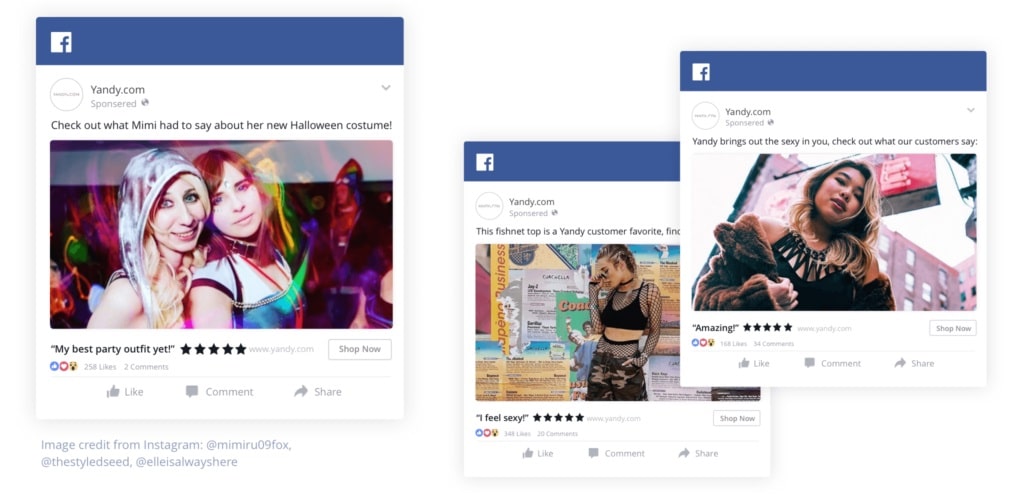
5 Different Types of Social Proof to Use in Email Marketing Campaigns
So, how might understanding how humans are driven to behave help you boost your email click-through rates? By including social proof features into your email marketing efforts.
Here are five sorts of social evidence to consider:
Customer feedback
If you have a wonderful product that your customers adore, incorporating testimonials in your email marketing campaigns may be a terrific way to show that enthusiasm to future consumers.
In their email marketing promoting the debut of their new ZenPayroll integration function, Freshbooks does an excellent job at this.
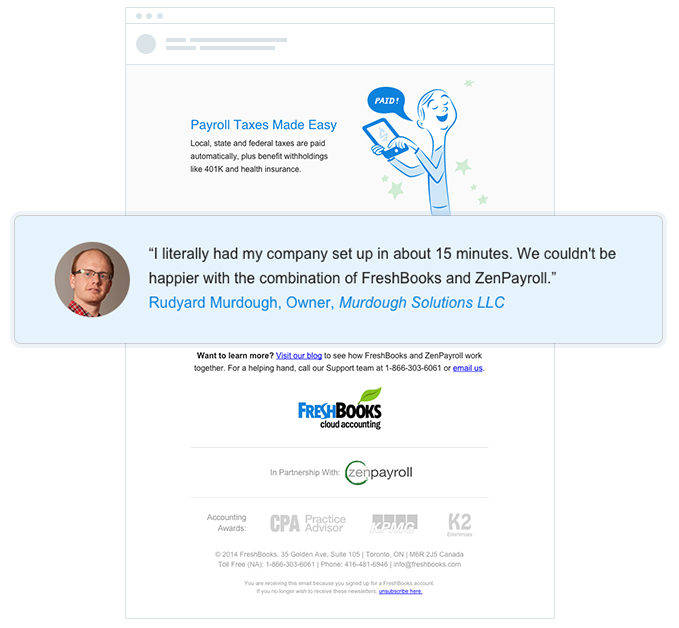
A testimonial from a satisfied client who is already using the solution may go a long way toward convincing others to check it out as well. Seeing that others, like Rudyard here, are having success with the product reassures others that they will as well.
Customer or use figures
While FOMO (Fear of Missing Out) is frequently mocked, it is a documented psychological phenomena in which individuals are motivated to act by the fear of missing out on chances that others are obtaining.
InVision successfully does this by highlighting the fact that 300,000 other designers are utilizing their technology to better their design process.
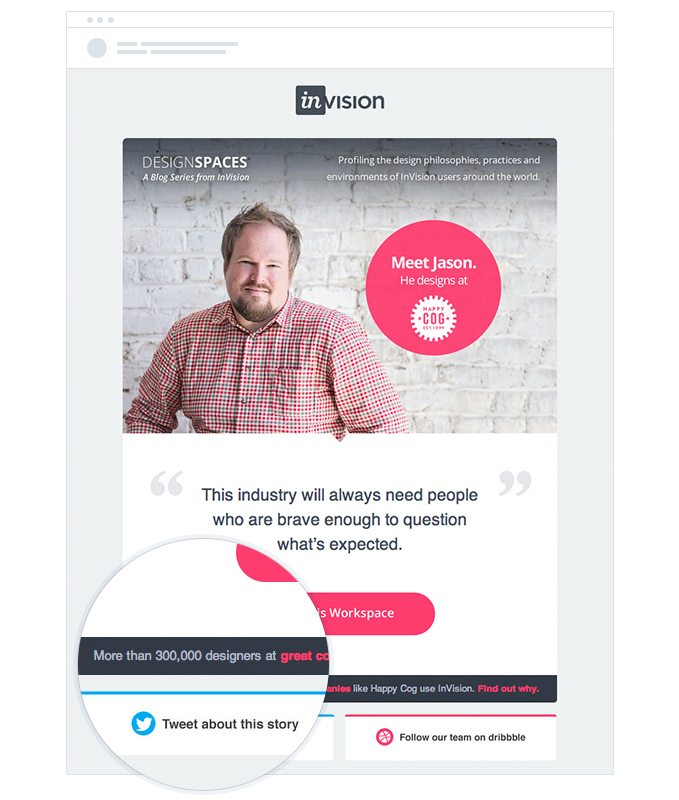
By displaying client numbers like this, InVision arouses people’s worry that other designers may be enjoying chances or perks that they aren’t, and they entice them to click-through from the email and test out their product.
Awards
Another approach to leverage social proof is to display honors obtained by your firm.
Industry awards, especially well-known ones, often have a high level of reputation among members of a certain industry. As a result, when you or your product receives one of these accolades, that credibility and respect is transferred to you as a result of a psychological phenomena known as the Halo Effect.
This was utilized by Werkpress in their campaign to announce the introduction of their new website.
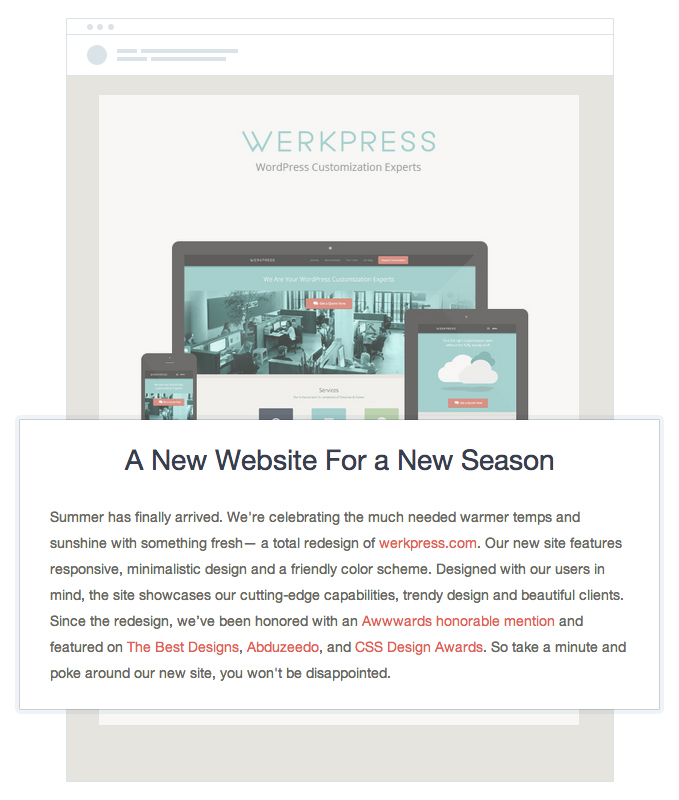
Following the announcement of the revamp, they go on to explain that the site has received an Awwwards honorable mention.
Because this is a well-known industry award (in the design field), the fact that their new site earned it lends it a new degree of legitimacy, encouraging visitors to click through the email campaign and check it out.
Product evaluations
Including evaluations from actual customers who have tried your product is an excellent method to boost your email click-through rate.
In fact, e-commerce shop Figleaves.com experienced a 37.5% boost in conversions when they experimented integrating product ratings in their marketing.
Franklin Rd excels at this in their email advertising.
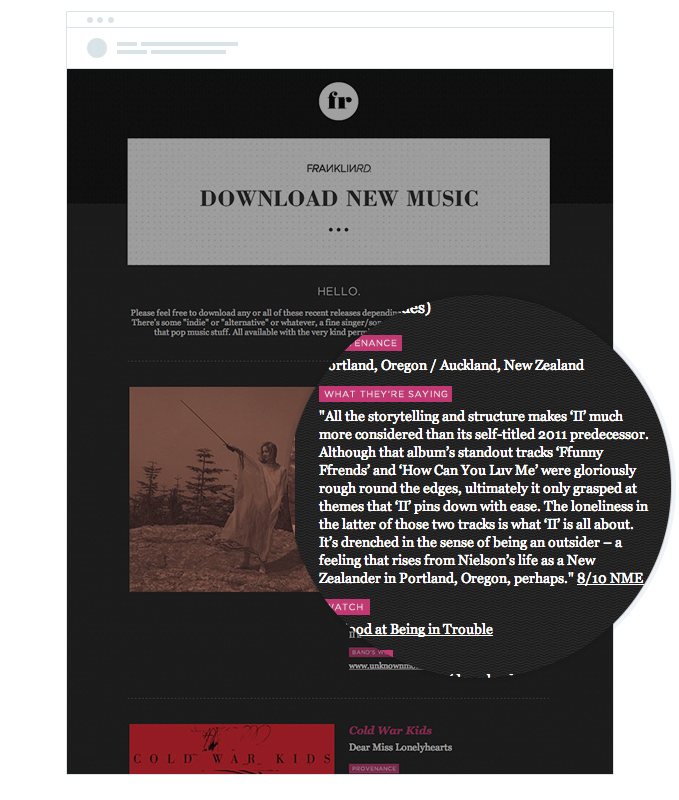
Franklin Rd reassures prospective listeners that going through and listening out the albums is worthwhile by including customer reviews in their marketing. This social proof feature, when paired with additional information and graphics such as the album cover, boosts the likelihood of consumers clicking through and generates conversions.
Mentions in the press
If your product has been reviewed (or merely referenced) by famous news sites or industry journals, adding it in your email marketing might be an excellent approach to enhance conversions.
These magazines, like industry awards, have a lot of credibility and authority with your prospective clients, and demonstrating that they’ve been talking about your firm provides you immediate credibility.
Oribe excels at harnessing media publicity in their email marketing.
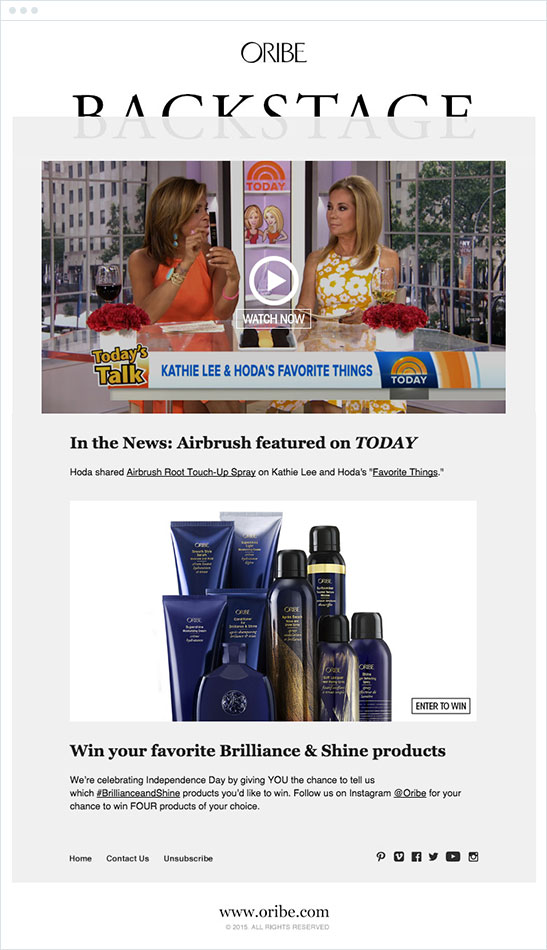
Oribe was lucky to have their product mentioned on The Today Show, and although that is a tremendous accomplishment in and of itself, it is their utilization of that mention as social proof that is really astounding.
By using it in their email advertising, they demonstrate to prospective buyers that their product is one of The Today Show’s “Favorite Things,” and they transfer the show’s reputation and likeability to their product.
How to Use Social Proof Effectively
Before you begin incorporating social proof into your email marketing, consider these best practices. Not all kinds of social proof are made equal—and doing it wrong might potentially hinder conversions.
Keep an eye out for unfavorable social evidence
When it comes to social proof, wording is crucial, and it’s simpler than you think to get it wrong.
Researchers evaluated various different signs to dissuade individuals from taking wood from the forest in a study done at Petrified Forest National Park in Arizona.
According to one of the signs:
Many previous visitors took the petrified wood from the park, damaging the Petrified Forest’s original form.
Despite the fact that the sign emphasizes the harm that theft does to the forest, the rate of theft increased while the notice was up.
Why? Because by informing people that many visitors before them had stolen wood from the park, they were demonstrating that this was a normal occurrence, ultimately making the criminal conduct more acceptable in people’s views.
To improve trustworthiness, personalize your testimonials
While testimonials continue to be a terrific approach to enhance conversions in your email efforts, it’s sad that some less trustworthy marketers than yourself have freely exploited testimonials.
As a consequence, consumers are less trusting of them, knowing how simple it is to make them up or cite friends or coworkers saying nice things about your product.
To avoid this, make sure your testimonials include information on the client, such as their entire name, position, firm, and perhaps a picture.
The usage of a testimonial in Freshbooks’ email above is a wonderful illustration of this.
Instead of merely publishing a quotation from “Rudyard M,” they provide his complete name, position, firm name, and even his photograph.
This reassures consumers that the testimony is genuine and lends credibility to the testimonial, making it more successful in driving conversion.
Displaying modest quantities of social evidence should be avoided
While social proof is beneficial, you should not begin utilizing it until you have something to show off.
InVision’s usage of their customer number in their email advertising works because it’s a significant number that arouses people’s dread of losing out on possibilities or perks that hundreds of thousands of other designers enjoy.
However, if they only had five clients, displaying that number would very certainly have the opposite impact. It would demonstrate to prospective buyers that not many other designers are utilizing this product and that it is most likely not worth their time investigating.
Examples of social proof in action in the real world
Social proof may take numerous forms, and when it comes to incorporating it into email marketing, email marketers must find a balance between evidence and content.
While selling a product is often the final aim, you also don’t want to overload your readers. That being said, here are a few real-world examples of email marketing that strike the ideal mix of social proof and content.
Coastal – reader’s choice and best in show
We liked this Coastal social proof example since they made it about the readers rather than their stuff. Are they trying to sell sunglasses? Yes, but they’re guiding readers through the “best in show” top selections based on consumer input.

Allow the readers to speak for themselves. This “best in show” example enables the business to promote their greatest sellers, but the content is supplied by the customers, who provide social evidence as to why each product was picked to be part of the best in show lineup.
Katie shed almost 60 pounds thanks to Body Boss
Body Boss’ example does an excellent job of appealing to the reader’s emotions. We have a real-world individual informing us about her real-world experience. It has all of the characteristics of excellent social proof: emotion, outcomes, and positive feedback for the thing being presented.
They also leave CTAs that will direct people to the right place if they believe they may benefit from their goods, like this lady did.

Allow your customers to tell their own stories. Consumer anecdotes are among the most effective types of social proof available. Giving a customer the opportunity to be honest and vulnerable will have an influence on your subscribers. It will appeal to their emotions, and if they are searching for comparable benefits from a product, it will be these real-world examples that will persuade them to make the ultimate purchase.
The verdict is in on Revolution Tea
Revolution Tea was so thankful for the positive reaction from customers that they put out a little “thank you” promotion to its readers. They also did an outstanding job of including some more social evidence at the conclusion of their email to assist validate their 94% recommendation rating from consumers.
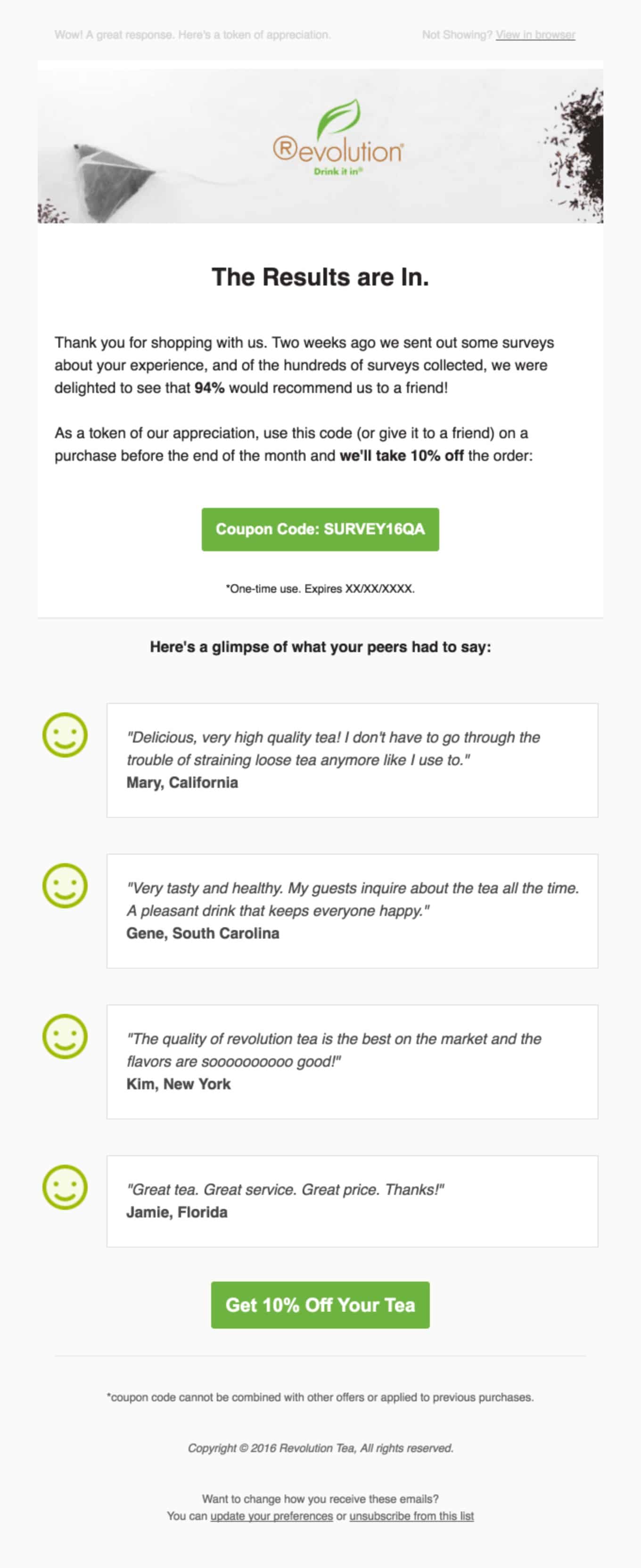
If you’re delivering statistics to your readers, include social proof in your email is a great method to back up that information. Just remember not to lie, since the truth will always come out. So, although employing social proof to back up positive statistics is a terrific concept, don’t provide readers misleading information in the process.
Conclusion
Social proof isn’t simply a marketing ploy; it’s a basic motivator of human behavior that has a significant impact on how individuals choose to behave.
You can use social proof to enhance your email click-through rate and drive sales by adopting the recommendations in this piece, which will help you write attractive emails to share your social proof with your readers.






Recent Comments